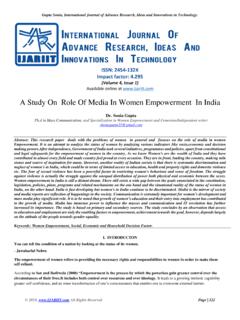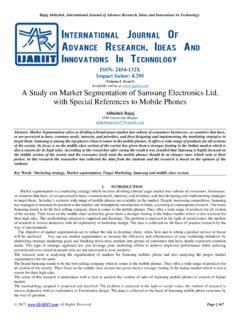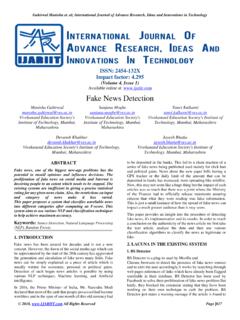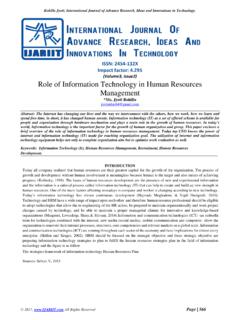Transcription of TECHNIQUES FOR NANOPARTICLE SYNTHESIS - IJARIIT
1 KITE/NCISRDC/ IJARIIT /2018/PHY/101 IJARIIT ( ISSN: 2454-132X) 2018. IJARIIT ALL rights reserved. Website: Page 443 TECHNIQUES FOR NANOPARTICLE SYNTHESIS D. K. Golhani1, B. Gopal Krishna2, Ayush Khare3, Dr. S. A. H. Zaidi4 [1][4]Kruti Institute of Technology and Engineering, Raipur (CG) [2] Pt. Ravishankar Shukla University, Raipur (CG) [3] National Institute of Technology, Raipur (CG) E-mail - ABSTRACT Innovative Nanoparticles SYNTHESIS TECHNIQUES are very important for the development of Nanotechnology and Nanoscience.
2 The scope for new synthetic methods for nanomaterials preparation has been ever demanding with innovative contribution. Various traditional physical and chemical methods are being used for fabrication of nanomaterials but more recently the advantageous use of biological means for nanoparticles SYNTHESIS is gaining importance. As these methods are ecofriendly, nontoxic, economical and easily controllable. In this paper, we discussed different SYNTHESIS routes for the fabrication of Nanoparticles. Keywords: Nanotechnology, Nanoparticles, Micro-organisms, Phytonanotechnology 1.
3 Introduction Nanoparticles particles having one or more dimensions of the order of 100nm or less have attracted great attention due to their unusual and fascinating properties, and applications advantageous over their bulk counterparts [1]. Although the SYNTHESIS of nanoparticles was found in ancient Indian medical and chemical science, where different kinds of Bhasma like Suvarna (gold), Rajat (silver) Bhasma, were used in ayurvedic medicine for the treatment of diseases. However, Michel Faraday is considered as the first to chemically synthesize gold nanoparticles, in solution from aqueous chloroauric acid and phosphorous dispersed in CS2 [2].
4 Since then, various physical, chemical and biological methods have been formulated for the fabrication of inorganic nanoparticles with a range of compositions, sizes and shapes. Some of the very successful physical methods for the SYNTHESIS of nanoparticles include photoirradiation[3], radiolysis[4], ultrasonication[5], spray pyrolysis, solvated metal atom dispersion[6], chemical vaporization[7], and electrochemical methods[8]. Chemical methods for the SYNTHESIS of inorganic nanoparticles are reduction or oxidation of metal ions, or by the precipitation of the necessary precursor ions in the solution phase.
5 The control of size, shape, stability and the assembly of nanoparticles can be achieved by incorporating different capping agents, solvents and templates. Various capping agents ranging from simple ions, to polymers to biomolecules are routinely used for the capping and stabilization of nanoparticles[9]. As a solvent, either water or non-aqueous organic solvents are used for the SYNTHESIS of nanoparticles depending on the ultimate application of nanoparticles. On the other hand, biological methods utilize nature s most efficient machines living cells for the SYNTHESIS of nanoparticles.
6 Biological methods also involve the use of biomolecules as templates or scaffolds for SYNTHESIS and assembly of nanoparticles. Many soft and rigid templates such as micelles[10], polymer materials [11], DNA[12], and mesoporous materials[13] have been employed to facilitate control over the formation of desired shape, size and assembly of nanoparticles. KITE/NCISRDC/ IJARIIT /2018/PHY/101 IJARIIT ( ISSN: 2454-132X) 2018. IJARIIT ALL rights reserved. Website: Page 444 1. Physical SYNTHESIS Methods Evaporation methods: Physical vapor deposition(PVD), sputtering and chemical vapor deposition (CVD) are the commonly used methods to form inorganic nanomaterials [14].
7 (i) PVD involves condensation from the vapor phase which is composed of three main steps: (a) formation of vapor phase by evaporation or sublimation of the material, (b) transporting the material from the source to the substrate, and (c) formation of the particle and/or film by nucleation and growth. Different TECHNIQUES have been used to evaporate the source such as electron beam, thermal energy, sputtering, cathodic arc plasma, and pulsed laser. Nanowire, nanorod, nanobelt, nanosheet, nanoribbon, and nanotube, etc., have been synthesized using PVD.
8 (ii) In CVD, the carrier gases containing the elements of the desired compound flow over the surface to be coated. This surface is heated to a suitable temperature to allow decomposition of the carrier gas and to allow the mobility of the deposited atoms or molecules on the surface. It consists of three steps: (a) mass transport of reactants to the growth surface through a boundary layer by diffusion, (b) chemical reactions on the growth surface, and (c) removal of the gas-phase reaction byproducts from the growth surface.
9 (iii) In sputtering, a discharge of non reactive ions such as argon is created which fall on the target and break the surface atoms, which are collected on the surface to be coated. Laser Ablation Method: In this method, metal atom desorption occurs, when intense laser pulses are focused on a metal target. In a Laser ablation experiment, a bulk metal is immersed in a solvent containing surfactant. During the laser irradiation, the metal atoms will vaporize and are immediately solvated by the surfactant molecules to form nanoparticles in solution [15].
10 Solvated Metal Atom Deposition (SMAD) Method: In SMAD, a bulk metal is evaporated under vacuum and the vapors of the metal are co-condensed with vapors of organic solvents like acetone to form nanoparticles in solution using a physical method [16]. Evaporation of metal is achieved by electrically heating a metal wire under vacuum. The resulting solution would consist only of colloids and solvent with no byproducts. KITE/NCISRDC/ IJARIIT /2018/PHY/101 IJARIIT ( ISSN: 2454-132X) 2018. IJARIIT ALL rights reserved. Website: Page 445 Photolytic and Radiolytic Methods: These methods involve the reduction of metal salts by radiolytically produced reducing agents such as solvated electrons and free radicals and the photolysis of metal complexes in the presence of some donor legands [17].









![Untitled-2 [www.columbia.edu]](/cache/preview/3/d/6/3/d/0/d/0/thumb-3d63d0d0343f66e2d86c238c9f8a44b3.jpg)





